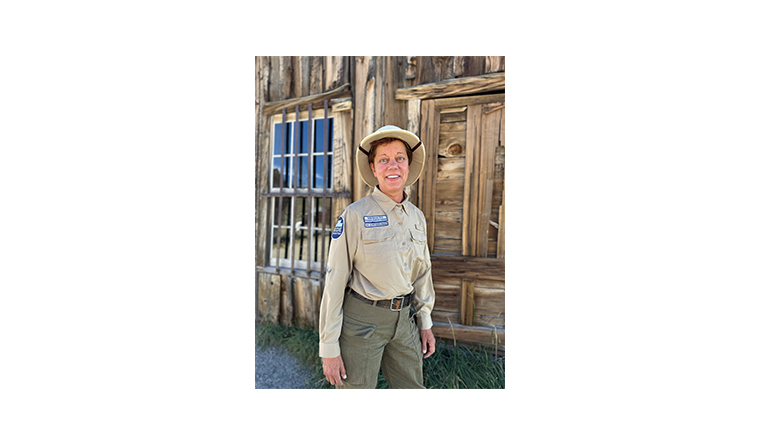
Dydia DeLyser
Dydia DeLyser is a writer and geographer whose work centres on the American cultural landscape and how the past is made meaningful in the present. Her community-engaged scholarship sees her working with different groups and organizations to help preserve the past for the future. She is a professor of geography at California State University, Fullerton, Secretary of the Museum of Neon Art and President of the Bodie Foundation, helping to preserve Bodie State Historic Park in California.
Largest gold-mining ghost town
The largest abandoned town built around gold mining is Bodie in California, USA. At its peak in around 1880, this boom town had an estimated population of between 7,000 and 8,000 people. The hype around Bodie’s boom proved as unsustainable as the area’s mineral wealth, and by 1881 the boom turned into a bust. Devoted miners and millworkers stayed, hoping to benefit from new strikes and new technologies, and a dwindling population remained until the 1960s. The abandoned town, which includes over 200 structures as of 2025, has been a California State Historic Park since 1962.
Bodie is located east of California’s Sierra Nevada mountains, at an elevation of around 2,554 m (8,379 ft), close to the border between the American states of California and Nevada. Prospectors first struck gold in the area in 1859 and set up a camp in the windswept valley where the town would later be built. One of these prospectors, Wakeman (W.S) Bodey, died in a snowstorm in November 1859, and his friends named their mining camp in his honour. Legendarily, the spelling reportedly shifted to "Bodie" after a sign-writer spelled it wrong on the sign for a local business.
Bodie remained a small mining camp through the 1860s and early 1870s, as the area was remote, unforgiving and not particularly productive. This changed in 1877, when the Standard Company discovered a rich gold deposit in the area. The mining camp was transformed into a boom town, with thousands of miners, mill workers and adventurers descending on the area in search of a good living or a quick buck.
This influx of people caused a functioning town to quickly spring up in place of the tents and shacks of the old mining camp. In its heart was Main Street, which ran on a north-south axis along the valley. This boasted shops, community halls and some 65 saloons, dance and gambling halls at its peak. Bodie's Chinatown could be found on King Street (Bodie had several hundred Chinese residents and a Taoist temple) as well as the town's extensive red-light district. To the west were the larger, fancier houses of Bodie’s middle-class businesspeople, and to the east were the industrial facilities associated with the mines.
Like many mining boom towns, Bodie at its height was a fairly dangerous and disreputable place for those who chose to participate in risky activities. Its population was dominated by men who were skilled mine and mill-workers and often equally devoted to drinking. Their actions inspired the cursing, drinking and heavily armed legend of the "Bad Man from Bodie".
But speculation in mining stock outpaced the mines’ output and by the end of 1880, Bodie’s boom began to crash; many of its residents sought their fortunes elsewhere. And the population dropped to less than 1,000. Nevertheless, innovations in mining technology, like the cyanide process for extracting gold and silver, caused miniature booms and the town clung to life. Devastating fires in 1892 and 1932 destroyed buildings along Main Street, but other buildings were moved into their places as townspeople continued to believe in Bodie’s future.
In 1942, the US War Production Board halted gold mining around the country, the US Postal Service closed Bodie’s post office, and Bodie’s school was shuttered. Still, a tiny-but-dedicated group of “Bodieites” pursued mining on a smaller scale and hoped for larger successes.
The decline of Bodie as a living, working mining town went hand in hand with its growing fame as an authentic wild-west "ghost town". It was first described using that phrase in 1915, which is one of the earliest known uses of the term in print, and it became a must-see destination during the early-to-mid-20th century, when American culture was dominated by romanticized depictions of the “wild west” - including legends and tales that originated in Bodie itself.
By the late 1950s, Bodie’s ghost-town appearance and atmosphere attracted preservationists and after years of negotiations, the entire town of Bodie was acquired by the State of California. In 1962, it was established as Bodie State Historic Park. There, State Parks developed the internationally influential preservation approach they called “arrested decay,” where buildings are not restored to newness or opened as tourist attractions but are maintained just as they were in 1962 - leaning and unpainted but not falling down. Arrested decay, the large number of buildings remaining in Bodie, and the fact that most are filled with discarded possessions, have made Bodie perhaps the archetype of the Western ghost town.



